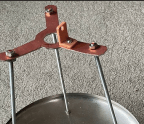PROPAGATION

During the daylight hours, energy from the Sun ionizes our upper atmosphere. This daytime energy causes distinct layers of ionized gas to form in the atmosphere above Earth. These layers comprise the ionosphere.
The layer closest to the Earth is the D layer. Generally, the D layer absorbs some or all of the energy of a traversing radio wave (a radio wave that propagates into, and possibly through, the layer). Hence the D layer is known as the absorption layer.
Above the D layer we find the E layer, which plays a role in Sporadic-E (Es) propagation. Depending on the level and type of solar energy reaching the E layer, some absorption of radio waves might occur.
Higher yet, we find the F layer (which can split into as many as three distinct layers, F1, F2, and over the equator, F3). The E and F layers refract radio signals back to Earth if the frequency of the radio signal is at or below the Maximum Usable Frequency (MUF).
As a radio signal travels through the D layer, it gets attenuated. How much attenuation depends on how ionized the D layer has become. During solar flares, if the flare is visible from Earth, X-ray radiation released by the flare penetrates the atmosphere, some reaching the D layer. The energy reaching the D layer increases the ionization in this region, creating a denser layer that absorbs radio signals. When the density is low, only the lower frequencies are affected (the medium wave through the low shortwave spectrum). But, when the density is increased, signals in the entire
You’re reading a preview, subscribe to read more.
Start your free 30 days

